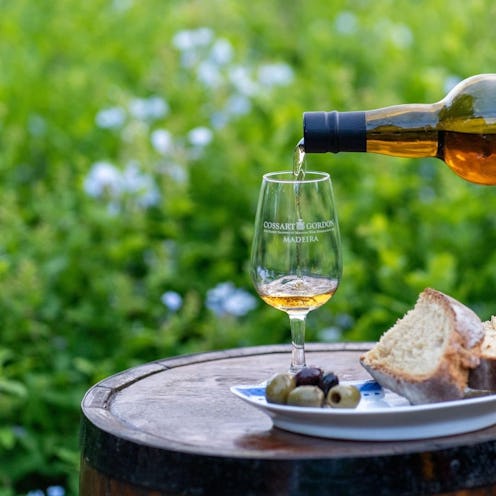(Entertaining)
Madeira Is The Fortified Wine That’s Taking Off For 2024
Cheers to that.

Madeira wine is what one might call an understated icon. In the fickle world of wine and spirits, this fortified Portuguese variety has stood the test of time thanks to its rich history and distinct production process, which makes it a category of its own. And it seems the people of the world agree: According to ReportLinker.com, the global fortified wine market grew from $18.81 billion in 2022 to $20.67 billion in 2023 at a whopping compound annual growth rate of 9.9%.
Juan Egídio Gomes Teixeira, the chief winemaker at Justino’s, Madeira Wines, S.A., explains that madeira “is a fortified wine, produced under specific conditions and made exclusively from grapes grown in the demarcated region of Madeira, comprising Madeira (main island) and Porto Santo islands.”
Teixeira shares that during the over 500-year history of Madeira, interest in the wine heightened around the 1600s when the sugar industry began to decline and farmers had to pivot, making “the [wine] vines the islands’ the most important crop,” to produce income in the region.
When making Madeira, a major part of the vinification and aging process “includes stopping fermentation by adding a neutral grape spirit in order to achieve the desired degree of sweetness… aging it in casks or wooden vats using the natural oxidative aging process known as ‘canteiro’ or an artificial heating process that accelerates maturation known as ‘estufagem,’” he explains. All Madeira undergoes one of these aging/heating processes for various lengths of time depending on factors like the grapes used, varietal, pricepoint, and desired final taste.
Francisco Manuel Machado de Albuquerque, winemaker and production manager, at Blandy’s Madeira Wine Company, Sa describes estufagem’s significance and how it closely mimics the wine’s original production process. “[Estufagem is a] technique that has its origins in the 15th century when Madeira wines crossed the Atlantic on a sea voyage to English and Portuguese’s colonies in the Americas and India, where the wines were submitted to high temperatures of the tropics causing it to evaporate and concentrate, thus transforming its floral and fruity aromas into complex notes of jam and spices and its golden color to darker ambers depending on the caramelization of the sugars,” he shares.
When it comes to the most popular grape varieties for Madeira, Teixeira counts Sercial, Verdelho, Boal, Malvasia, Terrantez, and Tinta Negra among the current favorites. He also makes the distinction that aside from Tinta Negra, these are all white grapes. “White varieties represent around 15 to 20% of production, while Tinta Negra (formerly known as Tinta Negra Mole) represents between 80 to 85% of the island's total production,” he explains. “Tinta Negra is the most versatile and can produce wines ranging from dry to sweet.”
Teixeira adds that each white grape variety has a specific characteristic and type. “Sercial is dry,” he says. “Verdelho is medium dry. Boal is medium-sweet. Malvasia is sweet. The only exception is Terrantez, which can produce medium-dry or medium-sweet wines.”
While Madeira is generally considered a dessert wine, its many varietals can be served throughout a meal. “It makes a good partner to lightly spicy or bitter dishes,” Teixeira explains.
If you have a dry or medium-dry Madeira, he reiterates their “marked acidity and low levels of residual sugar,” which make them “excellent aperitifs when served cool.” Teixeira’s suggests pairing medium-sweet Madeira at the end of a meal, together with cheese, custard, crème brûlée, caramel, light puddings, sweet cakes, tropical fruit or nut tarts. “Sweet wines go well with dark chocolate, cheeses with pronounced taste, strawberries, pineapple, and puddings made with coffee, such as tiramisu and coffee ice cream,” he advises. They can also be served in place of dessert. If you’re one for a post-meal cigar, Old Madeira like Frasqueira is an excellent choice.
Madeira Rules Of Thumb
As children, we’re taught not to judge a book by its cover, but in Teixeira’s professional opinion, that philosophy doesn’t translate when it comes to picking out a bottle of Madeira at the store. “When the bottle indicates a single grape variety (Tinta Negra, Sercial, Verdelho, Boal, Malvasia, Terrantez), harvest year, and a mention of “colheita” or “frasqueira,” it will be, for sure, a good bottle of Madeira wine,” he says.
For context, colheita is a style of Madeira that is produced from a single vintage and is aged for a minimum of five years and up to 19 years. Frasqueira is another style that is often considered the highest quality Madeira, having aged at least 20 years in oak barrels, according to Albuquerque. He calls these two styles of Madeira “top wines… because they are unique, produced in very limited quantities, with the vintage year and grape variety on the label or painted on the bottle,” so it’s hard to go wrong.
Next, Albuquerque mentions an important tip once you get your bottle home. “Madeira bottles are stored vertically, unlike table wines, which are stored horizontally,” he says. Teixeira agrees. “As it has already been oxidized, the wine will not be damaged by contact with air and a bottle of wine can be enjoyed over a period of time,” he states. “If kept in a cool, dark place, an opened bottle of Madeira will keep for months or even years without suffering any negative effects.”
“Of all fortified wines, Madeira is probably the one that ages best, and has the longest life span,” Teixeira assures, but for those who are a bit apprehensive about jumping into a Madeira experience, he has more concrete advice. “For a secure and distinct purchase, I suggest wines aged at least 10 years.”
Ahead, expert-approved Madeira picks that mix vintage vibes with timeless taste.
This article was originally published on